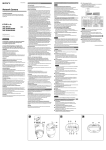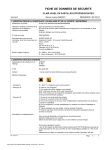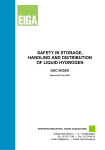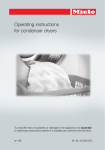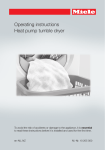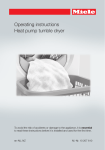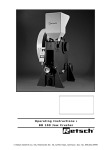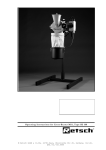Download Operating Instructions for the Disk Mill Model DM200
Transcript
Operating Instructions for the Disk Mill Model DM200 Retsch GmbH, 42781 Haan, Rheinische Str.36, Germany, Doc.Nr. GB 98.740.9999 Information on these Instructions Operating The present operating instructions for the laboratory model DM200 disk mill provides you with all of the necessary information on the areas specified in the table of contents. It is an instruction for the target group(s) defined for each of these areas in the safe and intended use of the DM200. The prerequisite of each of the target group(s) being able to use it safely and as intended is having a knowledge of the relevant sections. The present technical documentation is a reference work and instructions for learning and each of the sections is closed in and of itself. These operating instructions are not instructions for repair. If repairs should be necessary, please consult your vendor or get in contact with Retsch GmbH directly. 16.11.2006 Retsch GmbH 2 Doc.Nr. GB 98.740.9999 Information on these Operating Instructions ..... 2 Safety.................................................................. 4 Safety Information ........................................... 4 Warning Signs ................................................. 4 Repairs ........................................................... 5 Confirmation ................................................... 5 Technical Data .................................................... 6 Use as intended ............................................... 6 Functional Description ...................................... 6 Protective Equipment ....................................... 7 Drive .............................................................. 7 Motor Output ................................................... 7 Rated Voltages ................................................ 7 Rpm's ............................................................. 7 Protective Types .............................................. 7 Emissions........................................................ 8 Machine Dimensions......................................... 8 Floor Space Required........................................ 8 Transportation and Installation .......................... 9 Packaging ....................................................... 9 Transportation ................................................. 9 Intermediate Storage ....................................... 9 Scope of Delivery ............................................. 9 The Parameters for the Place of Installation ........ 11 Installation...................................................... 11 Electrical Connection ........................................ 11 Operation ............................................................ 12 The Operating Elements and Operation .............. 12 Adjusting the Gap Width ................................... 13 Starting the Machine ........................................ 13 Feeding the Material to be Crushed .................... 13 Changing the direction of rotation, replacing the milling disks .............................................. 14 General Information ........................................... 16 Accessories ..................................................... 16 Cleaning ......................................................... 16 Service ........................................................... 16 Necessary Safety Tests..................................... 16 Copyright ........................................................ 16 Modifications ................................................... 16 Safety Regulations (Table) ................................ 18 The Terms of the Warranty ................................. 19 16.11.2006 Retsch GmbH 3 Doc.Nr. GB 98.740.9999 Safety The DM200 laboratory disk mill is a highly modern high-performance product from Retsch GmbH and is state-of-the-art. If the machine is used as intended and if the user has a knowledge of the technical documentation here, it is completely safe when operated. Safety Information You as the operator have to ensure that the persons entrusted with working at the DM200: have taken notice of and understood all of the regulations in the area of safety, know all of the instructions for use and regulations of the target group relevant for them before commencing work, have access to the technical documentation of this machine at any time and without any problems. Before work is commenced on the DM200, ensure that new personnel has been made familiar with its safe and intended use either by having a competent person introduce it to them orally and / or based upon the present technical documentation. Improper operation may lead to personal injury, property damage or injury. You are responsible for your own safety and that of your employees. Ensure that no unauthorised persons have access to the DM200 laboratory disk mill. For your own protection, have your employees confirm that they have been instructed in the operation of the DM200. You will find the draft of the appropriate form after the section on safety. We will not be liable for any claims to compensation whatsoever for property damage or personal injury that were caused by not observing the following safety information. Warning Signs we give warnings with the following signs: ! personal injury property damage 16.11.2006 Retsch GmbH 4 Doc.Nr. GB 98.740.9999 Repairs These operating instructions are not instructions for repair. For your own safety, repairs may only be done by Retsch GmbH or an authorised agency or service technicians. In this case, please notify: The Retsch agency in your country your vendor Retsch GmbH directly your service address: Confirmation I have taken notice of the foreword and the section on safety. _______________________________________ ________ the signature of the operators _______________________________________ ________ the signature of the service technician 16.11.2006 Retsch GmbH 5 Doc.Nr. GB 98.740.9999 Technical Data machine model designation: DM200 Use as intended The DM200 laboratory disk mill is suited for finely milling soft to hard materials (up to 8 Mohs) in sets or continuously from the fields of mining and metallurgy, rocks and earth, the glass industry or soil research. Our applications laboratory would be glad to give you further information upon request. The DM200 is designed for quantities from 20 to approximately 150 Kg/h depending upon the setting of the discharge gap and the piled density and crushing behaviour of the sample. The feed size may not exceed an edge length of a maximum of 20 mm. ! ! The DM200 is not designed to be explosion protected and therefore it is not suited to milling explosive self-igniting or fire-promoting substances. If oxidised materials are milled such as metals, organic materials, wood, plastics, etc., there is the danger of self-ignition (dust explosion) if the proportion of fines exceeds a certain percentage. It is necessary to observe the appropriate safety guidelines when materials such as these are crushed. Do not modify the machine and only use the spare parts and accessories approved by Retsch. Otherwise the conformity with European directives declared by Retsch shall be rendered invalid. Furthermore, this leads to a loss of all warranty claims. Functional Description The material sample is crushed by two milling discs coarsely meshed on the inside working against one another in a milling space sealed against dust from the outside. One of these is driven by a powerful and slow moving gear motor. The material to be milled is filled into the centre of the stationary milling disc through a closable funnel and it escapes from the gap between the two disks after being crushed by compressing and shearing force. The width of the gap can be adjusted and controlled from outside and determines the mean granulation of the material to be milled. 16.11.2006 Retsch GmbH 6 Doc.Nr. GB 98.740.9999 Protective Equipment The following safety equipment reliably prevents persons from unintentionally putting their hands in the machine when it is running. funnel tube designed in conformity with EN 294. This prevents persons from putting their hands into the milling space when the flap is opened safety limit switch. This prevents the machine from starting up when the milling space is open. It also stops the motor within a safe period of time when the milling space is opened during operation safety limit switch. This prevents the machine from starting up when the collecting container is drawn out. It also stops the motor within a safe period of time when drawing out the collecting container. protective motor switch, ON/OFF switch. This switches off the machine automatically if there is a defect or if the motor is overloaded. position [ I ] the machine starts. position [ 0 ] the machine stops. This prevents the machine from starting up independently if there is an electrical defect or power failure. Drive standard three-phase gear motor Motor Output 1,500 Watt Rated Voltages 3~ 230 V 3/N~ 400 V 3~115 V 3~ 200 V 50 / 60Hz 50 / 60Hz 50 / 60Hz 50 / 60Hz approx. 5.7 A approx. 3.3 A approx. 11.4 A approx. 6.5 A Rpm's 50Hz = Rpm's 440 min-1 60Hz = Rpm's 528 min-1 Protective Types gear motor safety limit switch for the door safety limit switch for the collecting container protective motor switch, ON-OFF switch 16.11.2006 Retsch GmbH 7 IP 55 IP 67 IP 67 IP 55 Doc.Nr. GB 98.740.9999 Emissions Characteristic Noise Values : Noise measurement in conformity with DIN 45635031-01-KL3 The properties of the material to be crushed also has an effect upon the characteristic noise values. sound level LWA = 81 dB(A) emission read at the workpiece LpAeq = 69,4 dB(A) Machine Dimensions height: 400 mm, 500 mm with the vertical flap on the funnel. width: 430 mm, 900 mm with door opened at 180°. depth : 890 mm, 1,000 mm with door opened at 90° weight: approximately 140 kg Floor Space Required 430 mm x 1000 mm; a safety distance is not necessary. 16.11.2006 Retsch GmbH 8 Doc.Nr. GB 98.740.9999 Transportation and Installation Packaging Packaging is in accordance with the transportation path and satisfies the generally recognised packaging guidelines. Please store the packaging for the duration of the warranty period because your warranty claim would be endangered if there were a complaint and it were returned in insufficient packaging. Transportation In order to be able to transport the DM200 in a crane of a minimum load-bearing capacity of 250 kp, it should be hoisted with the hoisting equipment as shown in the adjacent figure. The DM200 may not be shocked, shaken or thrown during transportation. Otherwise, the electronic and mechanical component parts could be damaged. Temperature Fluctuations If there are strong temperature fluctuations (for instance, when being transported by aeroplane), the DM200 should be protected from condensation water. Otherwise, there could be damage to the electronic component parts. Intermediate Storage Please also ensure that the DM200 is stored dry if it is placed in intermediate storage. Scope of Delivery the DM200 disk mill the operating instructions Please check to see whether the delivery is complete including the accessories specifically ordered. Check to see whether the DM200 is in perfect working order (refer to the section on operation for this) If the delivery is incomplete and / or if there was damage during transportation, you have to notify the transporter and Retsch GmbH without delay (within 24h). Under certain circumstances, later complaints may not be recognised. 16.11.2006 Retsch GmbH 9 Doc.Nr. GB 98.740.9999 16.11.2006 Retsch GmbH 10 Doc.Nr. GB 98.740.9999 The Parameters for the Place of Installation ambient temperature : 5°C to 40°C If the temperature is above or below the ambient temperature, the electronic and mechanical component parts may be damaged changing the performance data in an unpredictable fashion. humidity : The maximum relative humidity is 80% at temperatures up to and including 31°C, decreasing linearly to 50% relative humidity at 40°C If the humidity is higher, the electronic and mechanical component parts may be damaged changing the performance data in an unpredictable fashion. Installation Altitude: a maximum of 2,000 m above sea level Installation Only place the DM200 on a solid and sturdy foundation. Electrical Connection The mains fusing should be designed as follows: at 3~ 230 and 3/N~ 400V = 16A at 3~ 115 and 3~ 200V = 20A you may find the voltage and frequency of the DM200 on the nameplate. please ensure that the values agree with the existing power mains. only connect the DM200 to the power mains with the aid of the cable connector supplied. You may have the connection made directly with a change-over switch to avoid having to call in an electrician. This has the benefit that the milling disc teeth may be used by both sides. This is described in the section "Changing the Direction of Rotation and Replacing the Milling Disc". Electrical and mechanical component parts may be damaged if the values on the nameplate are not complied with. ! 16.11.2006 Retsch GmbH Modifications or rebuilding it to a supply voltage other than stated on the machine nameplate should only be done by an electrician. Danger of Current Surge! 11 Doc.Nr. GB 98.740.9999 Operation The Operating Elements and Operation A B C C item A B C D E F G H I J D L element door funnel tube window milling gap collecting container milling disc doors milling disc housing safety switch for the door lubrication point door lock protective motor switch K gap adjustment crank L safety switch for the collecting container 16.11.2006 Retsch GmbH E D F G H H I J J K K function seals the milling space dustproof receives the material to be milled enables you to check the milling gap by means of blade gauge receives the crushed material to be milled crushes the material to be milled fed into it together with F crushes the material to be milled fed into it together with E prevents the machine from starting up when the door is open enables you to relubricate the coupling enables you to open and safely close the doors disconnect the motor from the mains if there is an overload position [I] the machine is switched on position [0] the machine is stopped enables you to adjust the gap together with C graduation line = 0.01 mm prevents the machine from starting up when the collecting container is drawn out 12 Doc.Nr. GB 98.740.9999 Adjusting the Gap Width You may adjust the gap width between the milling disc in the housing and in the door just by adjusting the graduated rotating crank mounted below the motor. 1 graduation line = 0.01 mm. You may adjust the gap from 0.1 to approximately 5 mm. Rotating Crank Window Caution! Do not go below the minimum gap width of 0.1 mm. You may control check the gap width setting through a window behind the funnel tube by means of a sensing gauge. You may also adjust the gap width when the machine is running. Material that is difficult to mill should be milled at least twice. Select a larger gap width as pre-crushing for the first pass and then you achieve the desired final fineness with the small gap in the second milling pass. Caution ! The smallest gap width is 0.1 mm. The milling discs may not touch one another because otherwise this could damage the milling discs. Starting the Machine It is only possible to start the DM200 when the door is closed and the collecting container has been inserted. The ON-OFF switch is on the right-hand side of the DM200. ON-OFF switch position [I] DM200 starts position [0] DM200 stops The ON-OFF switch also acts as a protective motor switch. If the motor is overloaded or if there is another electrical fault, this switch disconnects the DM200 from the mains. The DM200 can only start up when the DM200 is manually started with the ON-OFF switch. Feeding the Material to be Crushed After the gap has been set and the DM200 has been started, you commence material feed. Do not exceed a maximum edge length 20 mm. Open the lid of the funnel tube for this purpose. the lid of the funnel tube When feeding the material to be crushed, please ensure that the funnel tube lid is closed because otherwise the material to be crushed could fall back. Furthermore, the quantity of fed material to be crushed depends upon its millability. Therefore, note the decreasing intensity of the milling sound to ascertain the optimum feed quantity. 16.11.2006 Retsch GmbH 13 Doc.Nr. GB 98.740.9999 Caution! Only feed the material to be crushed after having started the DM200. If the DM200 starts up filled with material to be crushed, this may lead to damage in the mechanical component parts. Changing the direction of rotation, replacing the milling disks The milling disks are subject to natural wear after use over a long period. However, before they need to be replaced by new ones the direction of rotation of the motor can be changed so that the opposite side of the gear teeth can be used. By this means the service life of the milling disks can be extended. Changing the direction of rotation: By reversing the phases of the mains supply the direction of rotation of the motor can be changed. Since this necessitates intervention in the electrical connecting line of the DM200 the change in direction of rotation should be carried out only by a qualified electrician. However, it is possible to install a direction of rotation change-over switch when connecting up to the mains supply for the first time. It is then no longer necessary for an electrician to intervene when the the direction of rotation has to be changed again. Replacing the milling disk in the door: Disconnect the mains plug Remove the collecting vessel Slightly unscrew the hexagon bolts or hexagon nuts with an open-jawed spanner 16.11.2006 Retsch GmbH Keep the door closed Open the door Keep a firm hold on the milling disk while unscrewing both hexagon bolts with washers Remove the milling disk Clean the mounting of the milling disk in the door Insert a new milling disk so that its contact surface is level Screw in the hexagon bolts again – for zirconium oxide hexagon nuts are used 14 Doc.Nr. GB 98.740.9999 Replacing the milling disk in the housing: Disconnect the mains plug Remove the collecting vessel Lift up the cover Open the door Unscrew the hexagon bolts or hexagon nuts with an SW 30 open-jawed spanner Remove the milling disk Clean the mounting of the milling disk Place a new milling disk in position The milling disk must have a level contact surface Screw in the hexagon bolts with washers – for zirconium oxide hexagon nuts are used. Caution It is essential that the milling disks have a level contact surface. There should be no unevenness or other components under the milling disk. GS SS For zirconium oxide disks it is absolutely necessary that the rubber washer GS is placed under the steel washer SS. Caution Milling disks of zirconium oxide should be tightened with a torque of only 20-30 Nm. Do not forget the rubber washer GS. Milling disks of steel and tungsten carbide are tightened with a torque of 50-100 Nm. 16.11.2006 Retsch GmbH 15 Doc.Nr. GB 98.740.9999 General Information Accessories Cleaning You may pull out the collecting container for cleaning purposes. Open the door to clean the milling discs, the milling space and the funnel tube. You may now conveniently clean the entire area that has come into contact with the material to be crushed with the aid of a brush or vacuum cleaner. ! Do not clean the DM200 with flowing water. Danger from Current Surge Only use moistened rags. Solvents are not permitted. The protection type of DM200 is IP 55 Service The DM200 does not require service, although it should be relubricated on the lubricating nipple of the shifting sled. Conventional lubricating grease may be used for this purpose. A grease gun is also available as an accessory under the order no. 05.185.0006. Necessary Safety Tests The safety limit switches on the door and the collecting container should be checked on a monthly basis to see if they are in perfect working order: open the door: It may not be possible to switch on the DM200 any more with the ON/OFF switch. close the door: It must be possible to start the DM200 with the ON/OFF switch again. pull out the collecting container: It may not be possible to switch on the DM200 any more with the ON/OFF switch. push in the collecting container: It must be possible to start the DM200 with the ON/OFF switch again. ! If the machine is not functioning properly, do not continue to operate it and get in contact with our customer service. Copyright It is only allowed to pass on or copy this documentation or utilise and pass on its content with the express permission of Retsch GmbH. Non-compliance engages the obligation of compensation for damage. Modifications 16.11.2006 Retsch GmbH 16 Doc.Nr. GB 98.740.9999 We reserve the right to make technical modifications. 16.11.2006 Retsch GmbH 17 Doc.Nr. GB 98.740.9999 Safety Regulations (Table) process safety information intended use for the DM200 from the sections action hazards property damage and personal injury may be incurred if the safety information is not observed. do not mill any explosive selfigniting or fire-promoting materials do not mill materials whose fine proportion at a certain percentage may lead to an explosion. do not modify the machine and only use the spare parts and accessories approved by Retsch. packaging please store the packaging for the warranty period. temperature fluctuations protect the DM200 from condensate water forming if there are temperature fluctuations. do not shock, shake or throw the DM200 during transportation if the delivery is incomplete and / or if there is damage from transportation, you have to inform the transporter and Retsch GmbH without delay (within 24h). should not fall below 5°C should not go above 40°C transportation scope of delivery ambient temperature humidity electrical connection adjusting the gap width feeding the material to be crushed cleaning safety tests 16.11.2006 Retsch GmbH no claims to compensation for damage shall be accepted whatsoever danger to life and limb because of explosion because the DM200 is not designed to be explosion protected. danger to life and limb because of explosion because the DM200 is not designed to be explosion protected. otherwise the conformity with European directives declared by Retsch shall be rendered invalid. Furthermore, this leads to the loss of all warranty claims. if there is a complaint and it is returned in insufficient packaging, this may jeopardise your warranty claims. electronic component parts may be damaged. electronic and mechanical component parts may be damaged. under certain circumstances later complaints may not be recognised. electronic and mechanical component parts may be damaged and performance data may change unpredictably. do not exceed a relative humidity higher humidity may damage the of 80% at 31°C or 50% (descend- electronic and mechanical component ing linearly) at 40°C. parts and performance data may change unpredictably. the network does not agree with electronic and mechanical component the values on the nameplate. parts may be damaged. do not adjust a gap width < 0.1 if the milling discs come into contact mm with one another, they may be damaged. only feed material to be crushed if the DM200 starts up filled with when the DM200 is operating. material to be crushed, this may damage the mechanical component parts. do not clean the DM200 with flow- danger from current surge. ing water. the protection type of the DM200 is IP55 get in contact with customer serif defects are improperly repaired, this vice if the safety equipment funcmay lead to danger to life and limb. tions improperly.. 18 Doc.Nr. GB 98.740.9999 The Terms of the Warranty 1. We will remedy defects or furnish replacement at no charge if complaints are justified. The purchaser shall only be entitled to repudiation of contract or diminution if according to our decision it is not possible to remedy the defect or replacement cannot be made or the period for this cannot be maintained or it was our fault that an appropriate subsequent period set by the customer of at least six weeks was not maintained. If the remedy or supplying the replacement is finally unsuccessful, the customer may demand that the remuneration be reduced or withdraw from the contract at his choice. Further claims, especially to compensation for damage that were not incurred on the object itself, such as a loss of production, shall be excluded to the extent that we are not guilty of intent or negligence. We pass on the manufacturer's liability for external products. 2. 3. We shall bear the immediate costs incurred by remedying the defect or supplying a replacement under the proviso that the complaint has turned out to be justified. This shall also apply with reference to the costs of shipping and the appropriate costs of removing and installing. However, the customer shall bear the appropriate costs for providing his own installers and help on site. To the extent that our customer works abroad, we shall be entitled as a deviation from this to pay the costs necessary for remedying the defect, especially transportation, travelling and material costs from the German border. The warranty term for newly manufactured goods is two years, for used it is one year. The guarantee refers to deployment in a laboratory in 1-shift operation. In case of multi-shift operation or other areas of application, the guarantee term is shortened accordingly. No warranty is given for parts subject to wear and tear. 4. We shall assume the warranty for our goods being free of manufacturing deficiencies. The suitability, classification and functioning of our goods shall be exclusively determined according to the performance specifications in the order confirmation, even if this deviates from the order. In this case, the customer has the possibility of pointing out any differences to the order within two weeks after receiving our order confirmation and reaching an agreement with us on this. If he does not object to the specifications in the order confirmation, it shall be deemed as accepted. In the absence of a deviating agreement, we shall not be liable for the article of sale being suited to the purpose planned by the customer. The shall apply to the performance data that the customer expects unless we have been able to make appropriate practical laboratory experiments ahead of time and declared the corresponding performance data to be binding in our order confirmation in writing. 5. Our warranty shall also be invalid if persons other than those commissioned by us do repairs or otherwise interfere with or modify the goods supplied by us or do not use the suitable accessories to the extent that the deficiency occurring is in causal connection with that. Otherwise, the prerequisite for our warranty shall be complying with our operating instructions and instructions for use. 6. If the customer builds the goods in other systems or production plants or connects them up to them, or interlinks or processes them without our prior approval, our warranty shall be exclusively limited to the components supplied by us. 7. We may either remedy defects or exchange defective components at our choice at the place of installation of the object of sale or in our company. If the defect is remedied at the place of installation, the customer has to grant our representative temporally and spatially unobstructed access to the object of sale. Otherwise, the customer may only demand that the warranty work only be done during the business hours normal at the location. Should the warranty work be done outside of our normal business hours at the request of the purchaser, the customer has to bear the additional costs. If he wishes other special services going beyond the warranty work, these expenses shall be paid at the prices of us valid at the time. 16.11.2006 Retsch GmbH 19 Doc.Nr. GB 98.740.9999




















